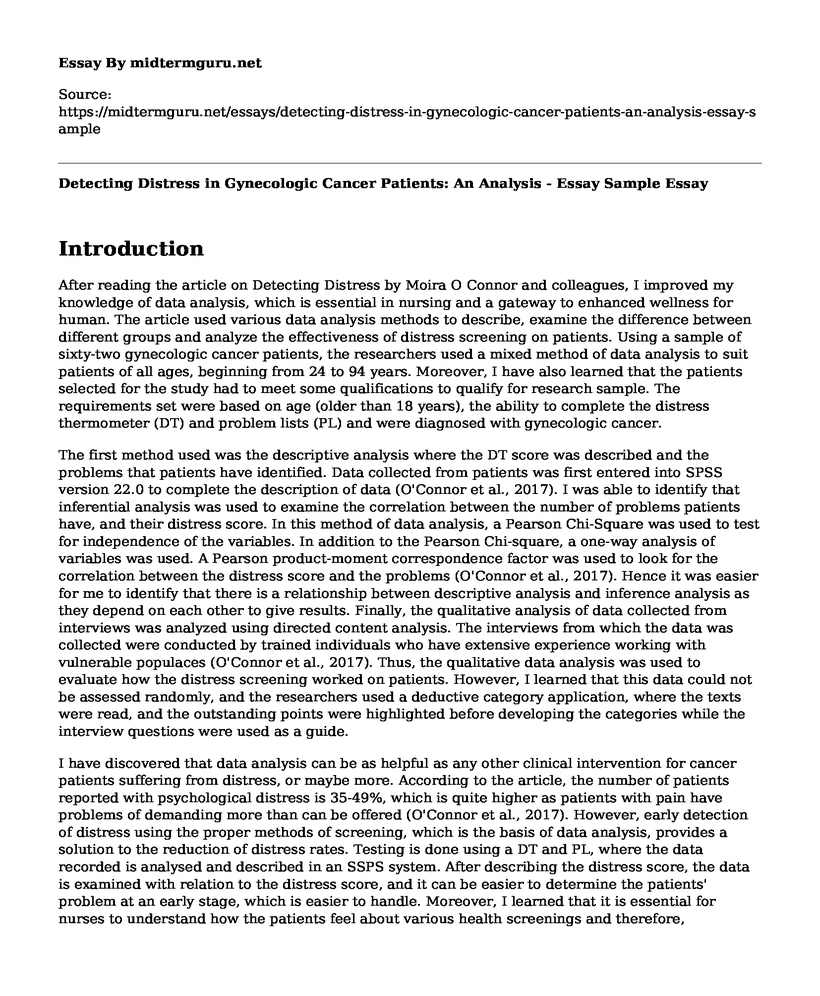Introduction
After reading the article on Detecting Distress by Moira O Connor and colleagues, I improved my knowledge of data analysis, which is essential in nursing and a gateway to enhanced wellness for human. The article used various data analysis methods to describe, examine the difference between different groups and analyze the effectiveness of distress screening on patients. Using a sample of sixty-two gynecologic cancer patients, the researchers used a mixed method of data analysis to suit patients of all ages, beginning from 24 to 94 years. Moreover, I have also learned that the patients selected for the study had to meet some qualifications to qualify for research sample. The requirements set were based on age (older than 18 years), the ability to complete the distress thermometer (DT) and problem lists (PL) and were diagnosed with gynecologic cancer.
The first method used was the descriptive analysis where the DT score was described and the problems that patients have identified. Data collected from patients was first entered into SPSS version 22.0 to complete the description of data (O'Connor et al., 2017). I was able to identify that inferential analysis was used to examine the correlation between the number of problems patients have, and their distress score. In this method of data analysis, a Pearson Chi-Square was used to test for independence of the variables. In addition to the Pearson Chi-square, a one-way analysis of variables was used. A Pearson product-moment correspondence factor was used to look for the correlation between the distress score and the problems (O'Connor et al., 2017). Hence it was easier for me to identify that there is a relationship between descriptive analysis and inference analysis as they depend on each other to give results. Finally, the qualitative analysis of data collected from interviews was analyzed using directed content analysis. The interviews from which the data was collected were conducted by trained individuals who have extensive experience working with vulnerable populaces (O'Connor et al., 2017). Thus, the qualitative data analysis was used to evaluate how the distress screening worked on patients. However, I learned that this data could not be assessed randomly, and the researchers used a deductive category application, where the texts were read, and the outstanding points were highlighted before developing the categories while the interview questions were used as a guide.
I have discovered that data analysis can be as helpful as any other clinical intervention for cancer patients suffering from distress, or maybe more. According to the article, the number of patients reported with psychological distress is 35-49%, which is quite higher as patients with pain have problems of demanding more than can be offered (O'Connor et al., 2017). However, early detection of distress using the proper methods of screening, which is the basis of data analysis, provides a solution to the reduction of distress rates. Testing is done using a DT and PL, where the data recorded is analysed and described in an SSPS system. After describing the distress score, the data is examined with relation to the distress score, and it can be easier to determine the patients' problem at an early stage, which is easier to handle. Moreover, I learned that it is essential for nurses to understand how the patients feel about various health screenings and therefore, conducting interviews and qualitatively analyzing the data recorded using a deductive category based on the interview questions helps identify how patients think about the nursing interventions. Thus, statistical analysis of psychological problems due to cancer can follow a method of data analysis to define, describe, compare, and evaluate the effectiveness of nursing processes.
Clinical significance connects to the real-life importance of research findings, while statistical significance refers to one's decision to reject the unacceptable assumption based on a preset measure. Thus a nurse researcher makes a statistical conclusion from study findings of a real population. Although statistical significance results to more accurate results about clinical practice, the clinical significance is more meaningful as it is based on real-life importance of nurse practice in terms of risk reduction, costs, patient values, quality of life associated with the results, among other indicators of clinical significance. Therefore, since the main objectives of nurses are to improve the quality of life of patients, clinical significance of practice is more sensible to a nurse as compared to statistical significance since what matters at the end of every clinical practice is the outcomes of the interventions.
Reference
O'Connor, M., Tanner, P. B., Miller, L., Watts, K. J., & Musiello, T. (2017). Detecting Distress: Introducing Routine Screening in a Gynecologic Cancer Setting. Clinical Journal of Oncology Nursing, 21(1), 79-85. https://doi.org/10.1188/17.CJON.79-85
Cite this page
Detecting Distress in Gynecologic Cancer Patients: An Analysis - Essay Sample. (2023, Feb 07). Retrieved from https://midtermguru.com/essays/detecting-distress-in-gynecologic-cancer-patients-an-analysis-essay-sample
If you are the original author of this essay and no longer wish to have it published on the midtermguru.com website, please click below to request its removal:
- Childhood Trauma - Paper Example
- Stressful and Traumatic Experiences of Police Officers - Paper Example
- Procrastination Among the College Students - Essay Example
- Essay Sample on Theme of AIDS in Movies: Dallas Buyers Club and the Philadelphia
- Essay Sample on Connections Among Nursing Analysis, Management, and Outcomes
- Smile Matters: Dental Appearance and Physical Perception - Essay Sample
- Patients at Risk: Inadequate Data Storage in Hospitals - Essay Sample







